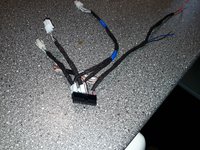OK, here is some info. Firstly - my apologies but I'm not a "how to" kind of guy... I just do something and forget it, I don't make any notes etc., just a few photos. Shame on me, I know

Anyway, here is what I remember.
I think I'll start from power. My panel is powered through purple (+12V) and light blue wire (ground for electronics), be aware that yours could have different colors in the 8 wire cable with RJ45 connector. Applying +12V will lit up all buttons and green power LED. In fact it is all what you need if you want to wire in a remote control for gate etc. Buttons - constant +5V is present in common path connecting all of them, it is clear when you look at the board where buttons are. Pressing a button closes a path and sends +5V to the processing part of the board.
My dual channel remote controller is a tiny PCB with KeeLoq chip that requires +12V power and +6 to +12V signal for each channel to activate it, in fact it is a key fob less for battery and buttons. I just soldered 2 wires downstream of the 2 panel buttons and cut the conductive path behind the soldering, +5V is not going any further now that the remote controller. There are very convenient places to solder wires in, these are holes that transit from one side of PCB to another, just like they would be made for this purpose

Now pressing END opens property gate, pressing D opens the garage door. Not the most elegant way but it works like a charm. Now few pics:
Powered up panel with remote controller wired in. All button light are on as soon as the power is applied.


Installed:

As you can see only green power LED is lit up. I also don't have a possibility to use the dimmer function (D button used for remote control) but the brightness level is just perfect in my opinion.
Hands free system - I always wanted to have one in 500E. I chose Bury CC9048 as it is relatively simple, small and didn't have any fancy displays etc. - just old school wired remote with 3 buttons. I was planning on use the built-in Motorola microphone but eventually desoldered all of the wires except for power supply (purple/blue). Bury microphone is some kind of fancy noise cancelling and state of the art piece of equipment (hahahaha nobody believes it) but on the other hand I thought that 25 years later electronics made some progress and it is better to use the modern one, especially that it was very easy to remove it from plastic casing. Picture:

What is inside the green square is the Motorola microphone circuit, microphone itself is desoldered on this picture, it should be located where the red star is. Arrows mark where the microphone signal (yellow) and ground (red, brown wire still in place) are leaded out. I think that signal wire was white but I cannot confirm it with any photo I have. Anyway, my original plan was to use this signal and feed it into HF but I abandoned it. I'm pretty sure it would be accepted, just don't know what the quality would be.
Now I needed to wire in the 3 button remote (green handset to receive/end calls, volume up and down). Unfortunately HF works other way that remote controller - pressing the button grounds it so I decided that it will be easier to wire in only the handset button. I separated the SEND button on Motorola panel by cutting all the conductive paths to/from it, wired in signal from the HF green (handset) button, and made a jumper to the ground path. Now pressing the SEND grounds the signal from original HF 3 button remote (that I still have hidden under the dash) and answers/ends calls. I hope it makes some sense... Photos:

HF controller installed and wired in. Sound is from front speakers only (it was a challenge to fish out 2 x negative wires for front speakers), original mute function utilized in BE1460, power comes from lighter, BATT from radio. Harness:

Ready product:

Desoldering the original microphone barrel gave me a space for the new one, it is not soldered into the PCB but has a short lead going to its own small PCB seen on above picture. I omitted here intentionally all the steps like separating everything from each other with non conductive material, heat shrinks, connectors etc., these are all obvious. Everything works as it should, sound in speakers is clear, radio mutes the music on incoming call, person on the other end of the line can hear me pretty well however "could be better" as my lovely wife stated. There is a gain adjuster for the microphone, I think I need to tweak it a bit.
This is rather primitive project compared with what Jlaa wants to do however it works well for me. This project is not completed yet - HF has a Bluetooth music streaming capability and low level signal out for this purpose. Plan is to inject this signal between tape head and Dolby chips - use Spotify instead of cassette...


















 Anyway, here is what I remember.
Anyway, here is what I remember.





